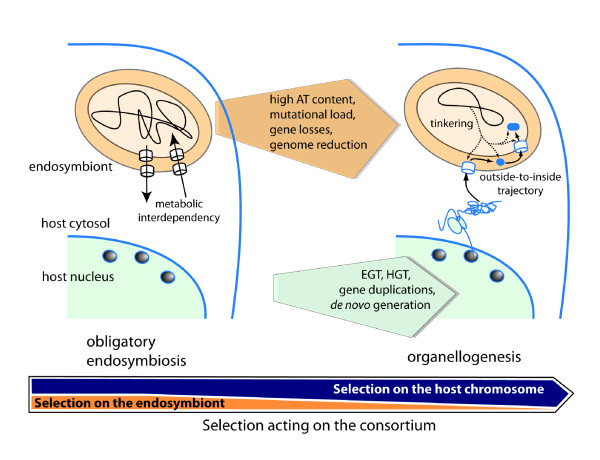Figure 1.
The outsiders' model for the conversion of a prokaryotic endosymbiont into an organelle. Schematic figure showing the process of organellogenesis, whereby a eukaryotic cell (shown in cross-section) harbors an obligatory Gram-negative endosymbiont (left) that is converted over time into an organelle (right). Obligatory endosymbiosis (right) implies mutualistic benefits that usually include metabolic interdependency between the host and its endosymbiont. At this point, selection is strong over both the host and the prokaryote to maintain or improve the benefits of the consortia (see arrow down). Genetic drift however leads to progressive genome degeneracy of the endosymbiont. This is marked by an increase in AT content, mutational load, losses of genes, and pronounced genome reduction. Strong selection for the maintenance and increase in fitness of the consortia progressively favors selection on the host chromosome. We suggest that in some cases this eventually may lead to the process of organellogenesis (right), which presumably initially includes the establishment in the host chromosome of molecular components to drive the biogenesis of OM proteins of the endosymbiont. Organellogenesis then progresses in an outside-to-inside trajectory of establishment in the endosymbiontic compartments of host-encoded molecular factors (blue) synthesized in the cytosol. This process is driven by EGT, HGT, gene duplication, subfunctionalization, and de novo generation of genes. Organellogenesis may eventually include the establishment of proteins that are tinkered from inside the organelle. The arrow down represents a trend of selection acting on the consortia, which tentatively can be described as a combination of selection acting on the endosymbiont (which tend to decrease over time) and of selection on the host chromosome (which tend to predominate during organellogenesis). The arrows indicate that the process unfolds over time (from left to right) and not to depict an actual relative time scale of the process of organellogenesis. It is possible that the period of obligatory endosymbiosis could have been relatively short compared to the time frame necessary for full evolution of an organelle such as the plastids and mitochondria. Note that the figure suggests a model useful to describe the evolution of any eukaryotic organelle derived from a prokaryotic endosymbiont. However it is not clear whether the host of the mitochondrial forerunner was a bona fide eukaryote or an Archaea in an ongoing process of evolving a nuclear compartment [1,4].

